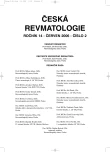-
Medical journals
- Career
Complex morphological examination of patients with ankylosing spondylitis
Authors: V. Peterová 1; Š. Forejtová 2
Authors‘ workplace: Radiodiagnostická klinika 1. LF UK, Praha 1; Revmatologický ústav, Praha 2
Published in: Čes. Revmatol., 14, 2006, No. 2, p. 71-79.
Category: Overview Reports
Overview
Objective:
Ankylosing spondylitis (AS) is a chronic progressive inflammatory rheumatic disease of musculoskeletal system. It represents seronegative spondylarthropaties affecting particularly axial skeleton. Different morphological image techniques such as plain radiography, computer tomography (CT) and magnetic resonance imaging (MRI) are used to detect local vertebral and ligamental changes in AS. An algorithm for evaluation of those changes is specific for each above mentioned image techniques. The aim of the study was to compare the benefit of particular images for the evaluation of acute and chronic affection of axial skeleton in patients with AS.Methods:
We examined 63 patients with AS (according the modified New York criteria). Disease activity was evaluated according the erythrocyte sedimentation rate, Creactive protein and disease activity questionnaire BASDAI (Bath Ankylosing Spondylitis Disease Activity Index). Functional impairment was assessed by BASFI (Bath Ankylosing Spondylitis Function Index). Total spine and sacroiliac (SI) joints were assessed by plain radiography. Spiral CT was used for the evaluation of C2-C7 in 35 patients. MRI was used to evaluate the most affected regions of the spine according to radiography in 49 patients. Simultaneous evaluation of cervical spine by spiral CT and MRI was performed in 30 patients. Conventional as well as contrast-enhanced MRI was performed in 17 patients. In the latter, acute and chronic changes in bone marrow of vertebra and adjacent discuses (vertebral unit) were performed according the Braun score system.Results:
Radiography still remains method of choice for the diagnosis of ankylosing spondylitis. In contrast to MRI, CT is superior to evaluate calcification and ossification of ligaments as well as bone morphological changes (vertebral fracture, osteophytes, olisthesis). MRI gives better information on changes in bone marrow, discs, entheses, and longitudinal ligaments. It can assess a width and signal of spinal cord. I.v. administration of contrast agents can reveal more acute MRI local changes compare to conventional examination in T1 and T2 weighted images. Correlations of the Braun score for acute MRI changes in the conventional T1 and T2 weighted images and contrast-enhanced T1 weighted image with CRP (T2WI: rs=0.1322, p<0.05; T1WI: rs=0.1478, p<0.05; T1Gd-DTPA: rs 0.1133, p<0.05), and also with BASDAI (T2WI : rs=0.1376, p<0.01; T1WI : rs =0.1434, p<0.01; Gd-DTPA: rs=0.1592, p<0.01) as well as with BASFI (T2WI: rs=0.4119, p<0.005 ; T1WI : rs=0.4530, p<0.01;T1 Gd-DTPA :rs=0.4751, p<0.005) were found. In the chronic changes, the most frequent local pathological changes were observed in conventional T1 weighted images, while not in those using T2 weighted images and contrast-enhanced T1 weighted images. The score of chronic changes correlated significantly with the period from the diagnosis (T2WI: rs=0.4298, p < 0.005; T1WI: rs=0.4318, p < 0.005; Gd-DTPA: rs=0.4395, p < 0.005) and with BASFI (T2WI: rs=0.2124, p<0.01; T1WI : rs=0.2119, p<0.01, Gd-DTPA: rs=0.2185, p<0.01). On the other side, it did correlate with the period from the first symptoms and with age of the patients.Conclusion:
MRI of the spine enables the most detailed evaluation of acute and chronic changes in patients with AS. The diagnosis of acute local changes is ameliorated by administration of contrast agents. Conventional T1 weighted images are optimal for the MRI diagnosis of chronic changes, while the administration of contrast agent is not beneficial.Key words:
ankylosing spondylitis, MRI, CT, radiography
Labels
Dermatology & STDs Paediatric rheumatology Rheumatology
Article was published inCzech Rheumatology

2006 Issue 2-
All articles in this issue
- Immunolocalization of 3-nitrotyrosine in human synovium
- The role of osteoprotegerin in diffuse idiopathic skeletal hyperostosis and ankylosing spondylitis
- The role of synovial fibroblasts in the pathogenesis of rheumatoid arthritis
- Complex morphological examination of patients with ankylosing spondylitis
- The role of vitamin D in prevention and therapy of glucocorticoid-/inflammation-induced osteoporosis
- Osteoporosis in some inflammatory rheumatic diseases
- Czech Rheumatology
- Journal archive
- Current issue
- Online only
- About the journal
Most read in this issue- Osteoporosis in some inflammatory rheumatic diseases
- Complex morphological examination of patients with ankylosing spondylitis
- The role of synovial fibroblasts in the pathogenesis of rheumatoid arthritis
- The role of vitamin D in prevention and therapy of glucocorticoid-/inflammation-induced osteoporosis
Login#ADS_BOTTOM_SCRIPTS#Forgotten passwordEnter the email address that you registered with. We will send you instructions on how to set a new password.
- Career

